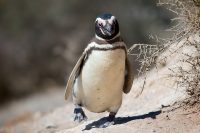You’d love all these interesting Galapagos penguin fun facts. The Galápagos penguin (Spheniscus mendiculus) is probably the only penguin that lives north of the equator. It is an endangered species. All other subspecies are found at the south.
Galapagos Penguin Facts
Size & Weight: Adult penguins grow 49 cm in length and weigh as much as 5.5 pounds. Galapagos penguins are one of the smallest penguins—second only to little blue penguins.
Galapagos penguins are almost entirely black from the back except for few white lines that run across their white chest. Males are bigger than females.
Habitat: They will make habitats in crevices, cracks, depressions in islands, and caves. Galapagos penguins likely stay closer to the shore to get easy access to the food.
Distribution: The Galapagos penguin lives in F ernandina Island. An isolated population occurs on the Galapagos Archipelago. Some of the penguins are also found in Santiago, northern Santa Cruz, Bartolome, and Floreana. They are the only penguins that occur in the Northern Hemisphere.
ernandina Island. An isolated population occurs on the Galapagos Archipelago. Some of the penguins are also found in Santiago, northern Santa Cruz, Bartolome, and Floreana. They are the only penguins that occur in the Northern Hemisphere.
Diet: Galapagos penguins eat sardines, small fish, crustaceans, schooling fish, and mullet. They are diurnal birds. Penguins only become active during daylight hours but they do not too far from their breeding sites.
Behavior: They will dive into the water for food when the sea temperature reaches 25 °C.
Reproduction: Females build nests in May and January. It then lays 2 eggs in a crevice or a cave. However one of the chicks is more likely to survive for a mother cannot feed both at the same time. Either male or female is there to look after the chicks.
Predators: Predators of Galapagos penguins are rice-rats, short-eared owls, Galapagos hawks, cats, crabs, and snakes.
Population: The global population size of Galapagos penguins consists of only 1,000 breeding pairs. It has the smallest population of all penguins.





